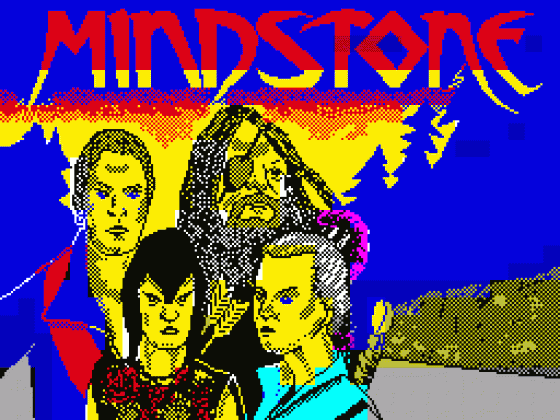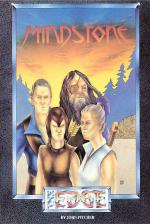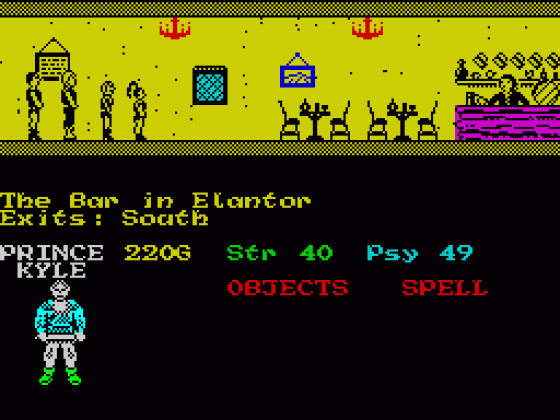Mindstone
It's the same old story, handsome young prince born first in line to the throne and doted over by his parents whilst the scraggy young brother gets all jealous and twisted and runs off with the magical heirloom that gives the King his powers and keeps everything jolly in the kingdom.
That's the story behind the new icon-driven, animated graphic advnture from The Edge, called Mindstone. The Mindstone is the magical object that has been stolen by the evil prince Nemesar, and it is your task in the game to take on the role of Kyle (the crown prince) and to lead him and his followers across the Shadowlands to confront Nemesar and regain the Mindstone.
Kyle's three followers are Merel, Taina and Quin, and like Kyle they all have their own Strength and Psyche scores which determine how successful they are likely to be in physical or magical combat. Each of the four characters can carry four objects and a single spell, so there is an element of judgement involved in deciding how to allocate the items that you find on your journey.

Merel is physically strong but psychically weak, whilst Taina is the reverse. Quin and Kyle are about average in both areas, so obviously you use Merel an Taina as specialists in their respective areas while Kyle and Quin are really just backup men as far as combat is concerned (though when their strength scores are at their peak they are both capable of knocking out the odd wolf or crocodile. And knowing just when to use which character is part of the skill of the game. Merel and Taina might be the specialists of the team, but if you use them too often you'll drain their abilities and find yourself lumbered just when you need them most.)
It's a bit tricky to describe Mindstone as it incorporates elements from games as diverse as Shadowfire, Tir Na Nog and even a bit of Lords Of Midnight, but basically the game is a graphic adventure with some animation, icons and a few other bells and whistles added on. That's not intended to sound too derogatory, since the whole thing is very well presented and quite absorbing and doesn't make any claims to be anything other than a graphic adventure, but perhaps I was expecting something as innovative as Fairlight, The Edge's last trip into arcade adventuring.
The top third of the screen is used to show a graphical representation of the current location, along with any other characters, gateways, etc that you might have to deal with. Your four characters are generally shown standing at the far left of this picture, but they can be seen to walk across the screen in response to your commands as they attempt to attack or trade in some way with other characters.
The remainder of the screen display contains icons of the four characters and a compass which you use to direct their movements. The author, John Pitcher, has allowed for both icon control of the game or a more conventional keyboard control.
If you choose icon control you can steer a pointer around the screen using a joystick, and once you have chosen the character you wish to instruct you can choose either an Actions or Attack menu which offer you a range of option for combat, spell casting or for dealing with objects or other characters. These include obvious adventure commands such as Attack, Examine, and so on, but also a number of others including Trade, Buy, Meditate and Dig. In icon mode, you choose the appropriate command by moving the flashing cursor around the menu, but in keyboard mode you have a system of single key entry (as in Lords Of Midnight) whereby each key corresponds to a specific command. Keyboard control means that you've got more to remember, but icon control is a little bit fiddly at times as you keep swapping from character to character and all the various menus. But the control system does work quite well, as the icon system allows you to get started quickly and without having to memorise all the control keys, then, as you become more accustomed to the game, you can speed up play by moving onto keyboard control (but you can only use one control system in each game, you can't swap from icons to keyboard in the middle of one).
As with all adventures it's vital that you make a map as you go along, although The Edge thoughtfully provide a rough sketch map of the Shadowlands on the cassette inlay. I suppose that because of the animation I was expecting more of an arcade element in the game, perhaps something like Enigma Force or Fairlight but as I mentioned earlier Mindstone is really just a graphic adventure with souped-up icon driven presentation, and once you treat it as that, both you and the game are more likely to do each other justice.
As with most adventures, problem solving is a matter of gathering together the correct objects in the right place, though, as usual, there are always more objects to carry than you can use at any one time so you've got to choose which objects to tae with you and which ones to leave behind for later use. When bartering for items or deciding which character to use in a fight there's the added element of judgement that you've got to use and quite often the consequences of an action won't become clear until much later in the game.
The memory taken up by the icon system means that Mindstone isn't as complex or as rich in brain-bubbling puzzles as a Level 9 game might be, but on the other hand the control system is very 'user friendly' and allows you to get into the game quickly and without having to sit there wondering which is the right word to use all the time, so Mindstone is well worth having a look at whether you're an adventure novice or a hardened orc basher.


 1st October 1986
1st October 1986

